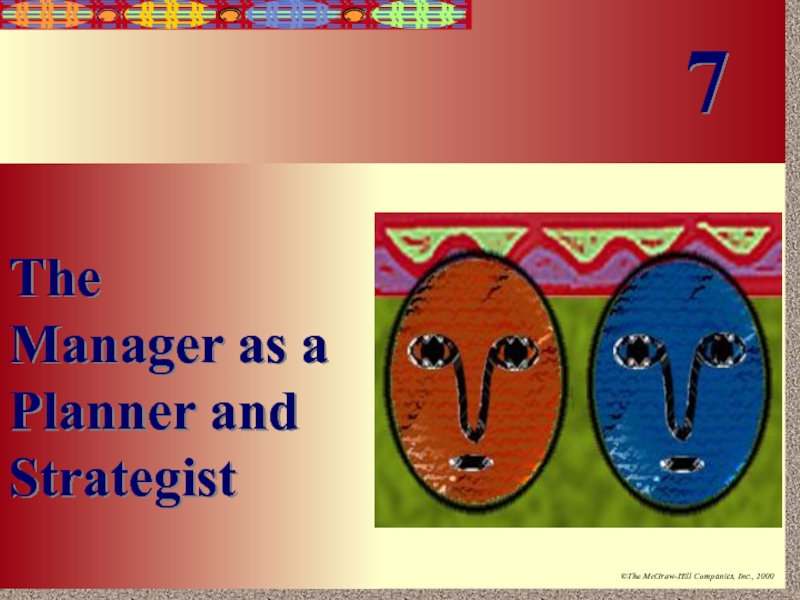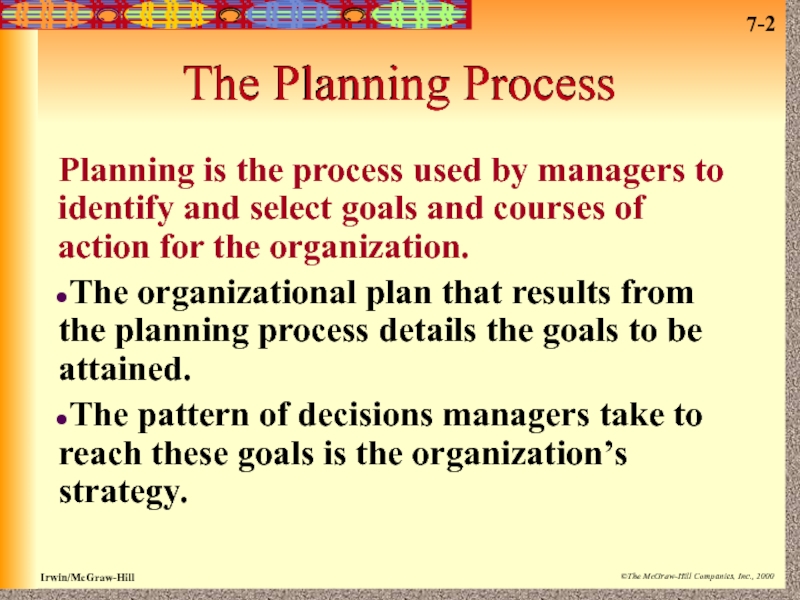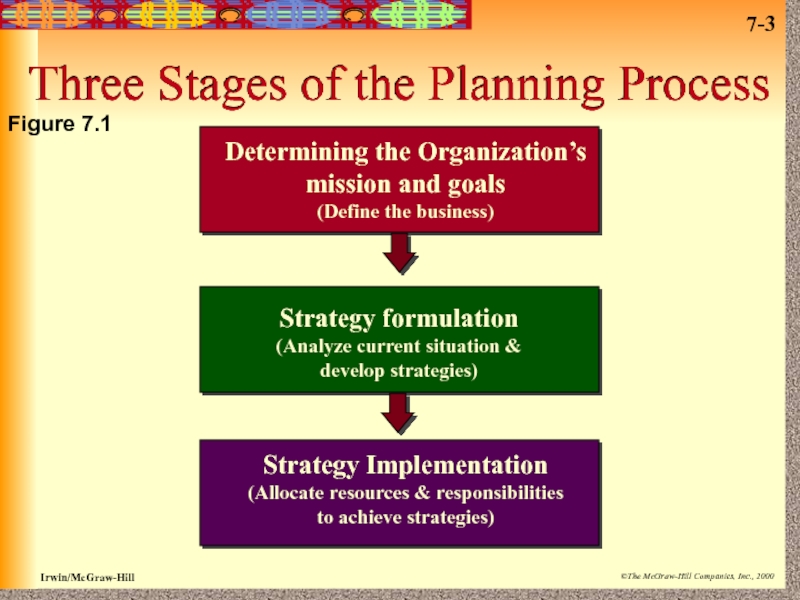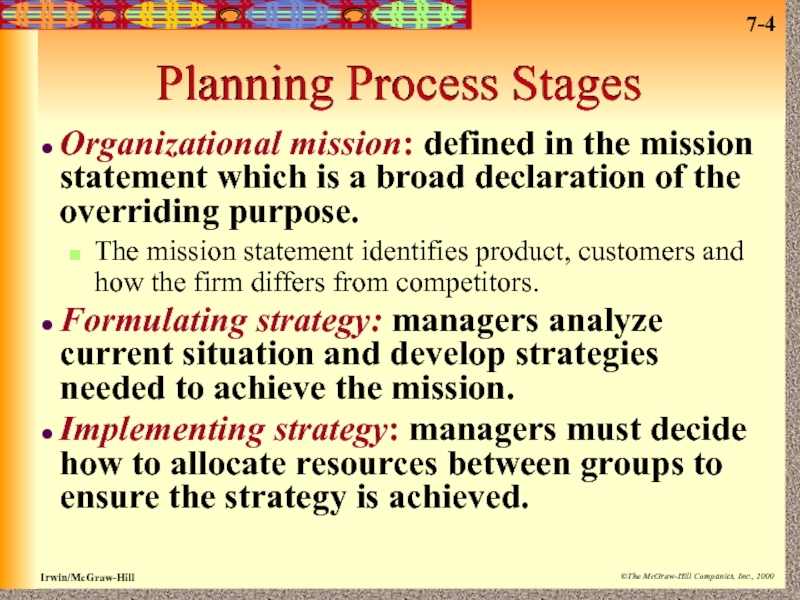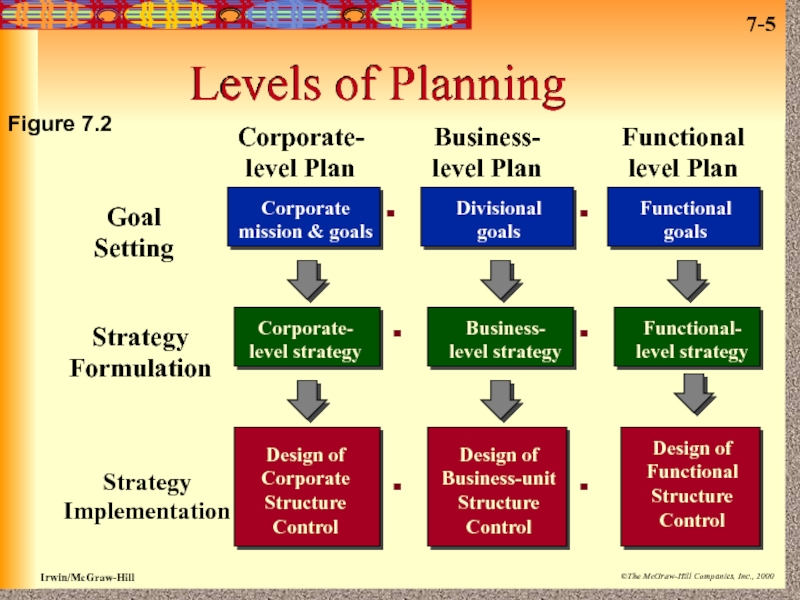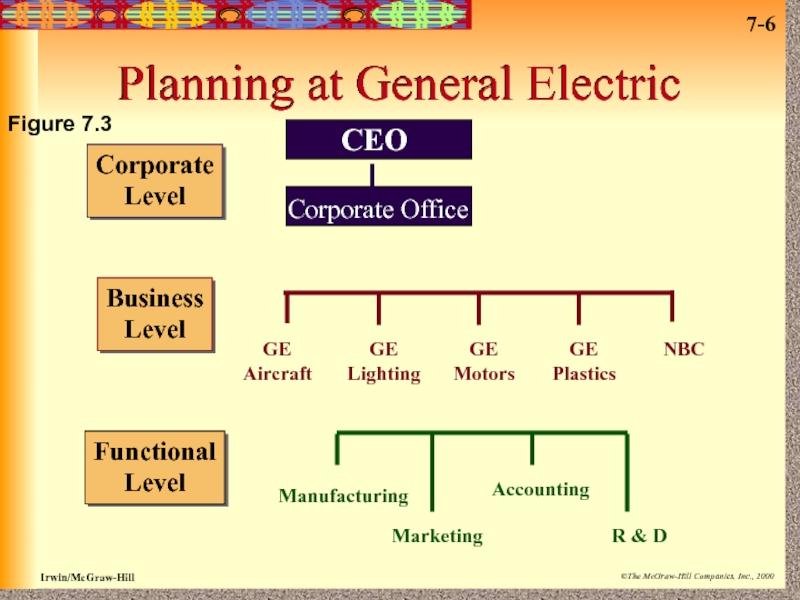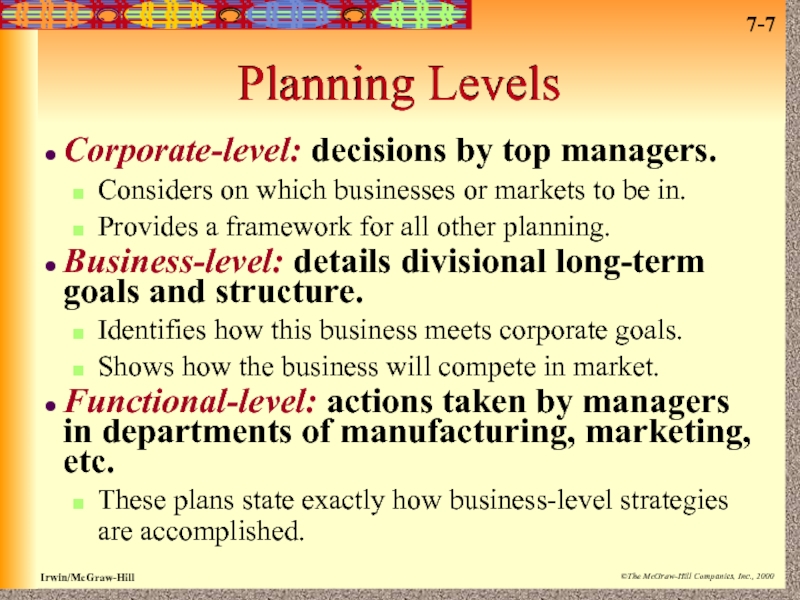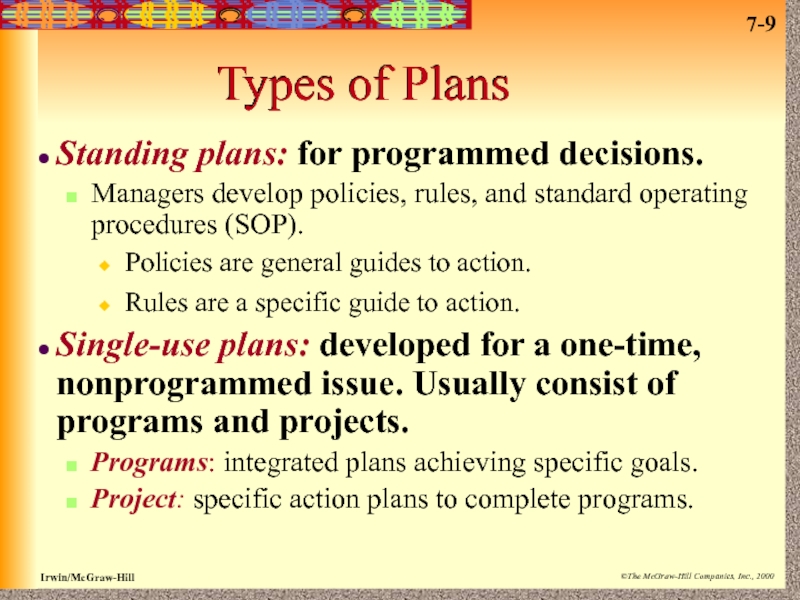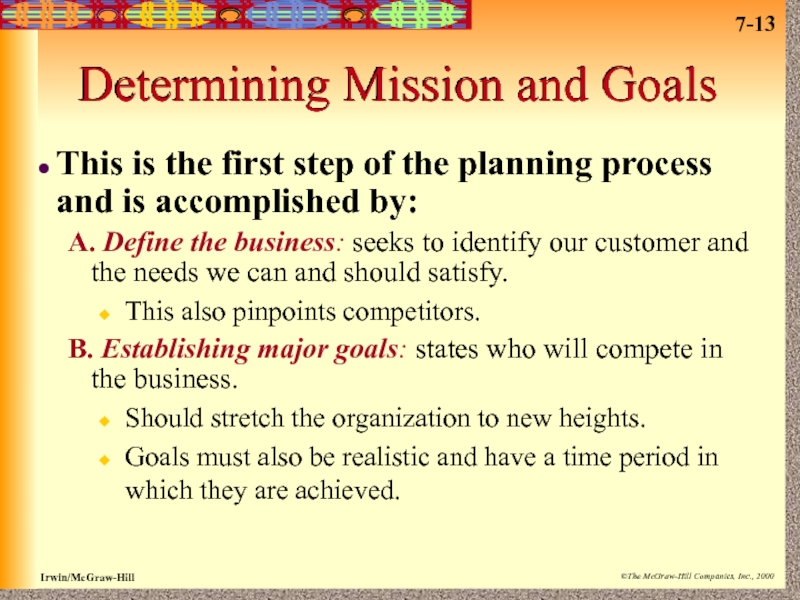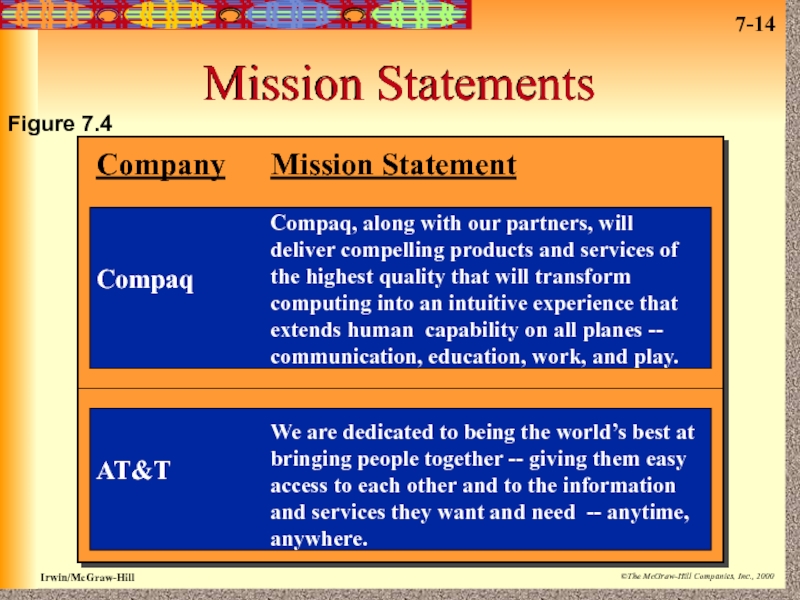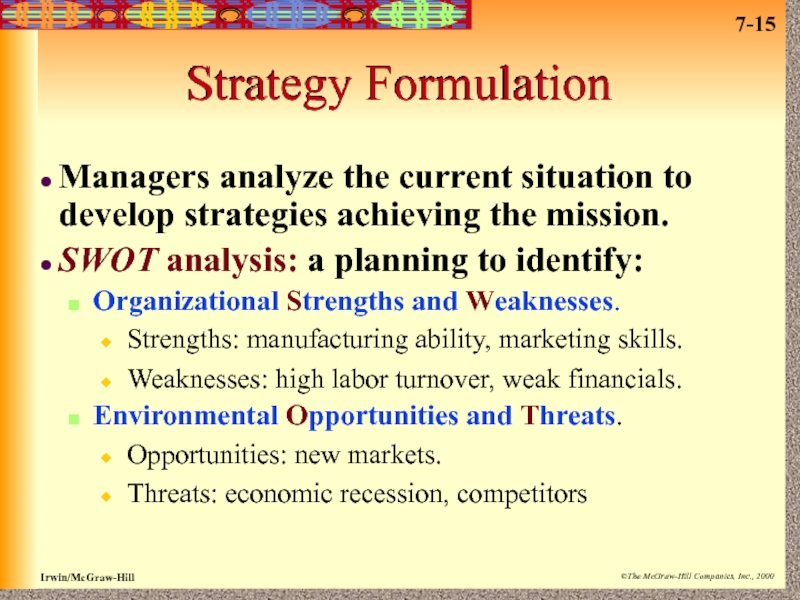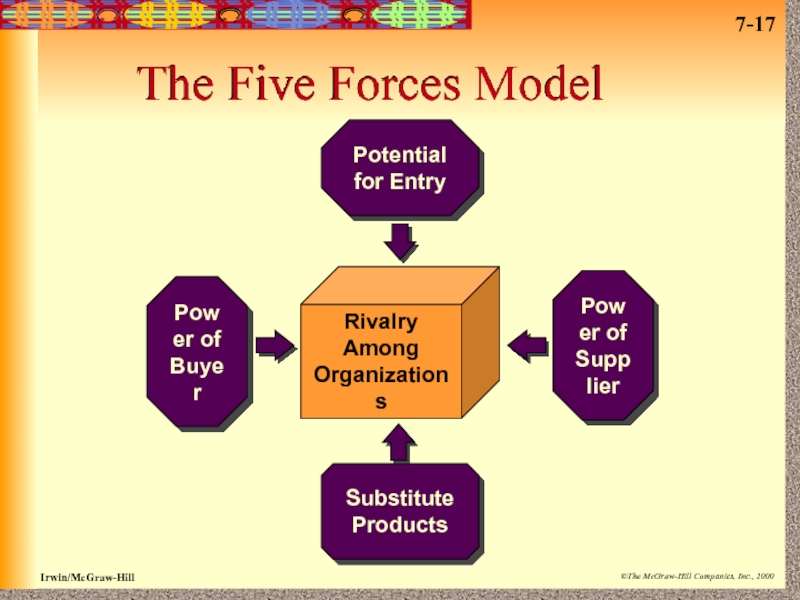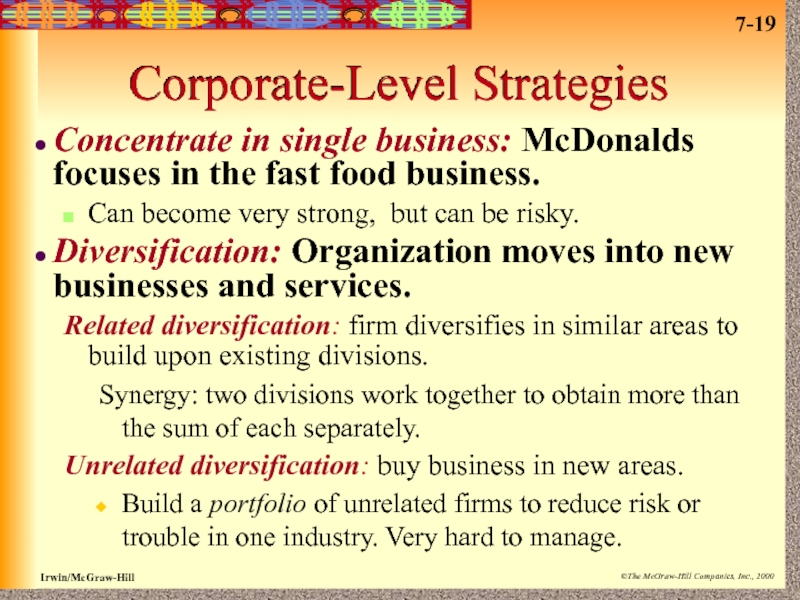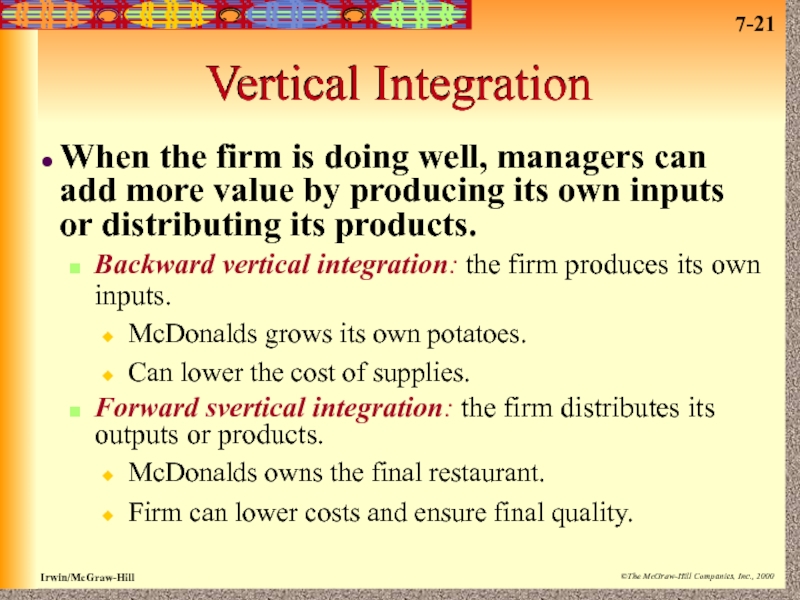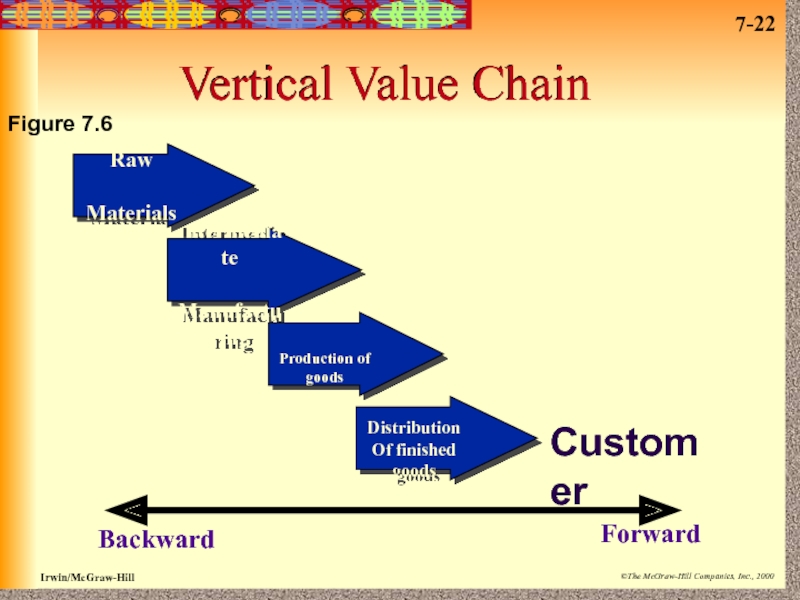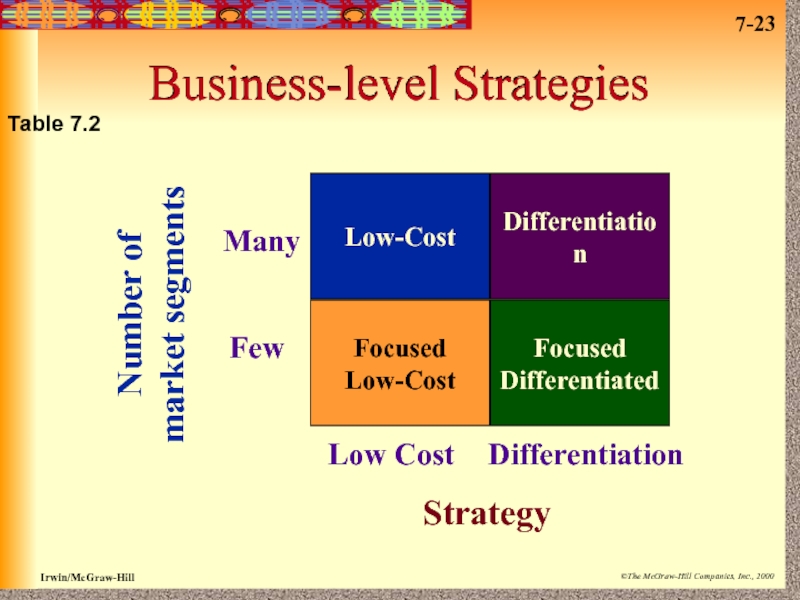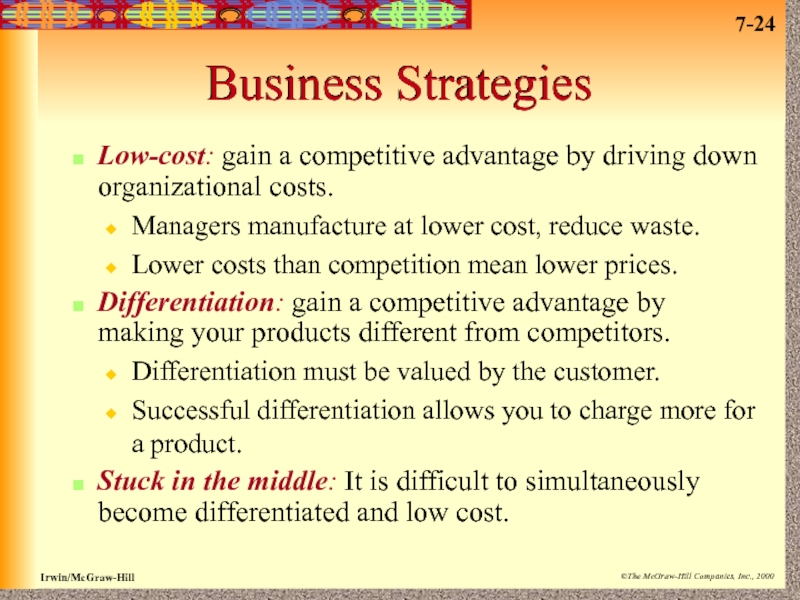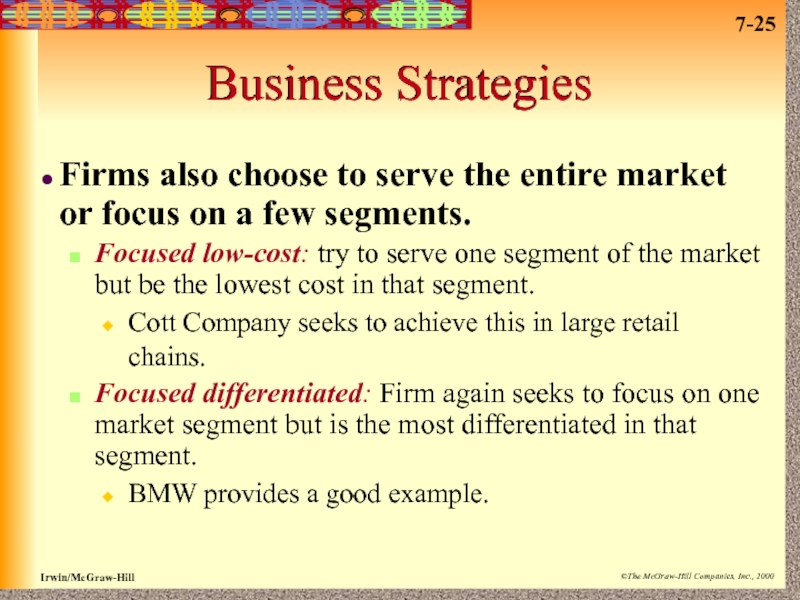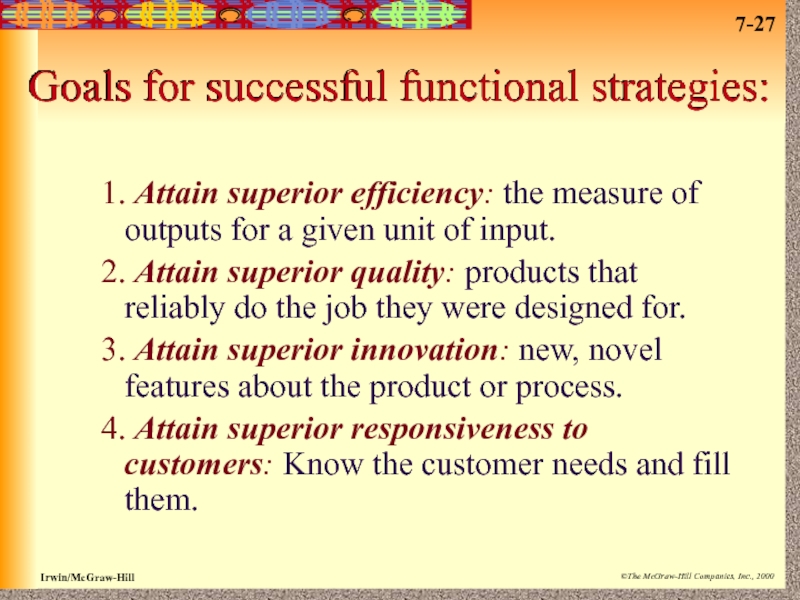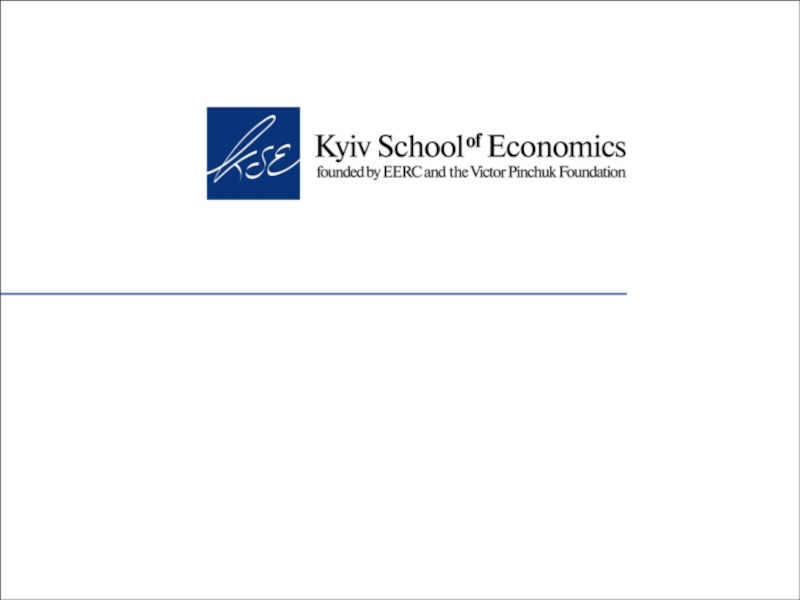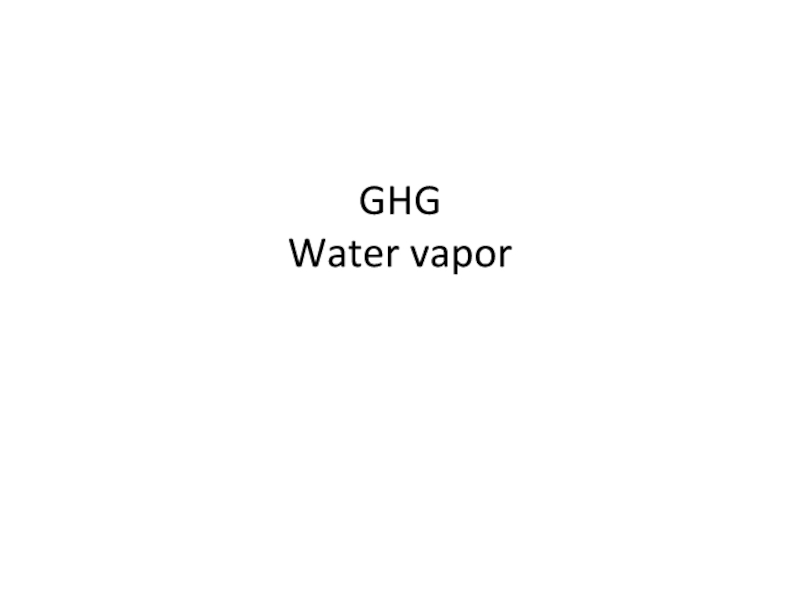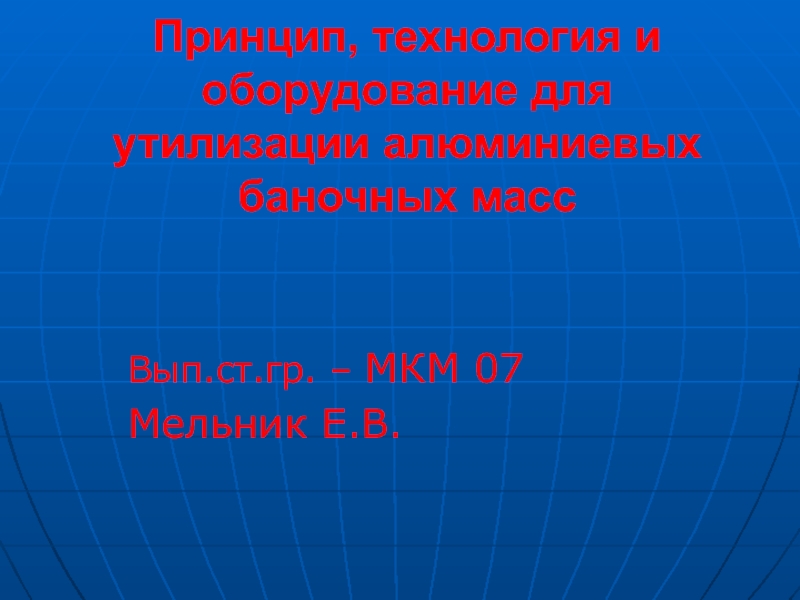Слайд 1The
Manager as a
Planner and Strategist
7
Слайд 2The Planning Process
Planning is the process used by managers to
identify and select goals and courses of action for the
organization.
The organizational plan that results from the planning process details the goals to be attained.
The pattern of decisions managers take to reach these goals is the organization’s strategy.
Слайд 3Three Stages of the Planning Process
Determining the Organization’s
mission and
goals
(Define the business)
Strategy formulation
(Analyze current situation &
develop strategies)
Strategy Implementation
(Allocate
resources & responsibilities
to achieve strategies)
Figure 7.1
Слайд 4Planning Process Stages
Organizational mission: defined in the mission statement which
is a broad declaration of the overriding purpose.
The mission statement
identifies product, customers and how the firm differs from competitors.
Formulating strategy: managers analyze current situation and develop strategies needed to achieve the mission.
Implementing strategy: managers must decide how to allocate resources between groups to ensure the strategy is achieved.
Слайд 5Levels of Planning
Figure 7.2
Слайд 6Planning at General Electric
Corporate
Level
CEO
Corporate Office
Business
Level
GE
Aircraft
GE
Lighting
GE
Motors
GE
Plastics
NBC
Functional
Level
Manufacturing
Marketing
Accounting
R &
D
Figure 7.3
Слайд 7Planning Levels
Corporate-level: decisions by top managers.
Considers on which businesses or
markets to be in.
Provides a framework for all other planning.
Business-level:
details divisional long-term goals and structure.
Identifies how this business meets corporate goals.
Shows how the business will compete in market.
Functional-level: actions taken by managers in departments of manufacturing, marketing, etc.
These plans state exactly how business-level strategies are accomplished.
Слайд 8Characteristics of Plans
Time horizon: refers to how far in the
future the plan applies.
Long-term plans are usually 5 years or
more.
Intermediate-term plans are 1 to 5 years.
Corporate and business level plans specify long and intermediate term.
Short-term plans are less than 1 year.
Functional plans focus on short to intermediate term.
Most firms have a rolling planning cycle to amend plans constantly.
Слайд 9Types of Plans
Standing plans: for programmed decisions.
Managers develop policies,
rules, and standard operating procedures (SOP).
Policies are general guides to
action.
Rules are a specific guide to action.
Single-use plans: developed for a one-time, nonprogrammed issue. Usually consist of programs and projects.
Programs: integrated plans achieving specific goals.
Project: specific action plans to complete programs.
Слайд 10Who Plans?
Corporate level planning is done by top managers.
Also approve
business and functional level plans.
Top managers should seek input on
corporate level issues from all management levels.
Business and functional planning is done by divisional and functional managers.
Both management levels should also seek information from other levels.
Responsibility for specific planning may lie at a given level, but all managers should be involved.
Слайд 11Why Planning is Important
Planning determines where the organization is now
and where it will be in the future. Good planning
provides:
Participation: all managers are involved in setting future goals.
Sense of direction & purpose: Planning sets goals and strategies for all managers.
Coordination: Plans provide all parts of the firm with understanding about how their systems fit with the whole.
Control: Plans specify who is in charge of accomplishing a goal.
Слайд 12Scenario Planning
Scenario Planning: generates several forecasts of different future conditions
and analyzes how to effectively respond to them.
Planning seeks to
prepare for the future, but the future is unknown.
By generating multiple possible “futures” we can see how our plans might work in each.
Allows the firm to prepare for possible surprises.
Scenario planning is a learning tool to improve planning results.
Слайд 13Determining Mission and Goals
This is the first step of the
planning process and is accomplished by:
A. Define the business:
seeks to identify our customer and the needs we can and should satisfy.
This also pinpoints competitors.
B. Establishing major goals: states who will compete in the business.
Should stretch the organization to new heights.
Goals must also be realistic and have a time period in which they are achieved.
Слайд 14Mission Statements
Company
Compaq
AT&T
Mission Statement
Compaq, along with our partners, will deliver compelling
products and services of the highest quality that will transform
computing into an intuitive experience that extends human capability on all planes -- communication, education, work, and play.
We are dedicated to being the world’s best at bringing people together -- giving them easy access to each other and to the information and services they want and need -- anytime, anywhere.
Figure 7.4
Слайд 15Strategy Formulation
Managers analyze the current situation to develop strategies achieving
the mission.
SWOT analysis: a planning to identify:
Organizational Strengths and Weaknesses.
Strengths:
manufacturing ability, marketing skills.
Weaknesses: high labor turnover, weak financials.
Environmental Opportunities and Threats.
Opportunities: new markets.
Threats: economic recession, competitors
Слайд 16Planning & Strategy Formulation
Corporate-level strategy
develop a plan of action
maximizing long-run
value
Business-level strategy
a plan of action to take
advantage of opportunities
and
minimize threats
Functional-level strategy
a plan of action improving
department’s ability to
create value
SWOT analysis
identifies strengths &
weaknesses inside the
firm and opportunities
& threats in the
environment.
Figure 7.5
Слайд 17The Five Forces Model
Substitute
Products
Rivalry
Among
Organizations
Potential
for Entry
Power of
Supplier
Power of
Buyer
Слайд 18The Five Forces
1. Level of Rivalry in an industry: how
intense is the current competition with competitors?
Increased competition results in
lower profits.
2. Potential for entry: how easy is it for new firms to enter the industry?
Easy entry leads to lower prices and profits.
3. Power of Suppliers: If there are only a few suppliers of important items, supply costs rise.
4. Power of Buyers: If there are only a few, large buyers, they can bargain down prices.
5. Substitutes: More available substitutes tend to drive down prices and profits.
Слайд 19Corporate-Level Strategies
Concentrate in single business: McDonalds focuses in the fast
food business.
Can become very strong, but can be risky.
Diversification: Organization
moves into new businesses and services.
Related diversification: firm diversifies in similar areas to build upon existing divisions.
Synergy: two divisions work together to obtain more than the sum of each separately.
Unrelated diversification: buy business in new areas.
Build a portfolio of unrelated firms to reduce risk or trouble in one industry. Very hard to manage.
Слайд 20International Strategy
To what extent do we customize products and marketing
for different national conditions?
Global strategy: a single, standard product and
marketing approach is used in all countries.
Standardization provides for lower cost.
Ignore national differences that others can address.
Mulitdomestic strategy: products and marketing are customized for each country of operation.
Customization provides for higher costs.
Embraces national differences and depends on them for success.
Слайд 21Vertical Integration
When the firm is doing well, managers can add
more value by producing its own inputs or distributing its
products.
Backward vertical integration: the firm produces its own inputs.
McDonalds grows its own potatoes.
Can lower the cost of supplies.
Forward svertical integration: the firm distributes its outputs or products.
McDonalds owns the final restaurant.
Firm can lower costs and ensure final quality.
Слайд 23Business-level Strategies
Low-Cost
Differentiation
Focused
Low-Cost
Focused
Differentiated
Strategy
Many
Few
Low Cost
Differentiation
Number of
market segments
Table 7.2
Слайд 24Business Strategies
Low-cost: gain a competitive advantage by driving down organizational
costs.
Managers manufacture at lower cost, reduce waste.
Lower costs than competition
mean lower prices.
Differentiation: gain a competitive advantage by making your products different from competitors.
Differentiation must be valued by the customer.
Successful differentiation allows you to charge more for a product.
Stuck in the middle: It is difficult to simultaneously become differentiated and low cost.
Слайд 25Business Strategies
Firms also choose to serve the entire market or
focus on a few segments.
Focused low-cost: try to serve one
segment of the market but be the lowest cost in that segment.
Cott Company seeks to achieve this in large retail chains.
Focused differentiated: Firm again seeks to focus on one market segment but is the most differentiated in that segment.
BMW provides a good example.
Слайд 26Functional-level Strategies
Seeks to have each department add value to a
good or service.
Marketing, service, production all add value to a
good or service.
Value is added in two ways:
1. lower the operational costs of providing the value in products.
2. add new value to the product by differentiating.
Functional strategies must fit with business level strategies.
Слайд 27Goals for successful functional strategies:
1. Attain superior efficiency: the
measure of outputs for a given unit of input.
2. Attain
superior quality: products that reliably do the job they were designed for.
3. Attain superior innovation: new, novel features about the product or process.
4. Attain superior responsiveness to customers: Know the customer needs and fill them.
